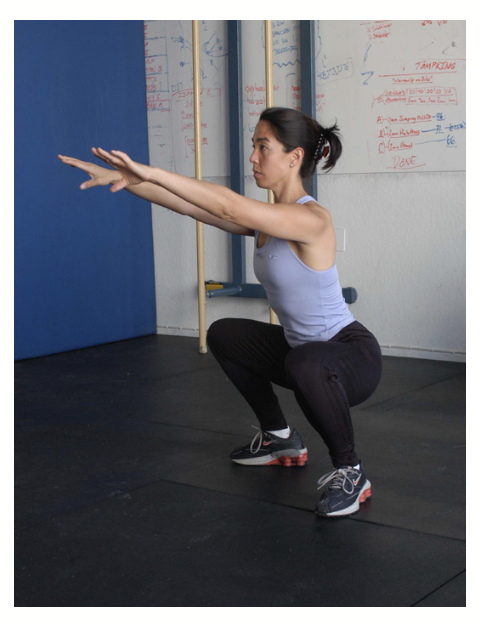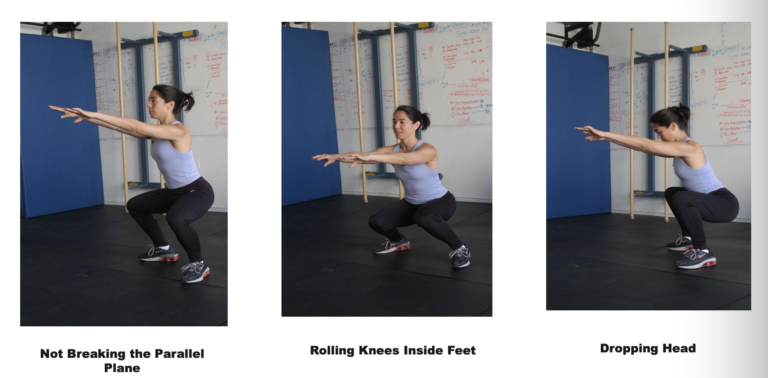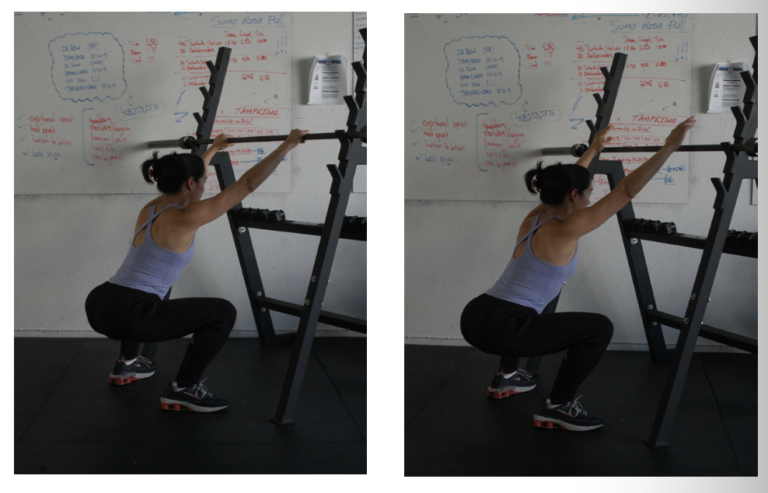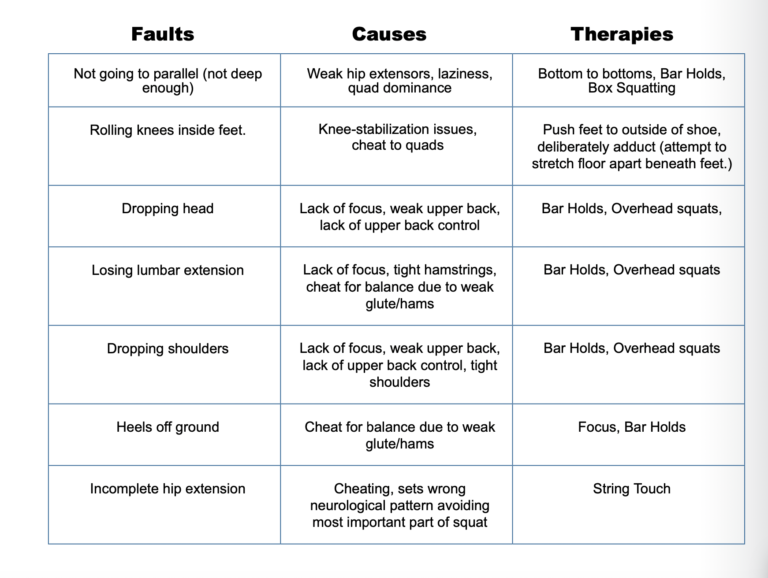Why Squat?
 The squat is essential to your well-being. The squat can both greatly improve your athleticism and keep your hips, back, and knees sound and functioning in your senior years.
The squat is essential to your well-being. The squat can both greatly improve your athleticism and keep your hips, back, and knees sound and functioning in your senior years.
Not only is the squat not detrimental to the knees it is remarkably rehabilitative of cranky, damaged, or delicate knees. In fact, if you do not squat, your knees are not healthy regardless of how free of pain or discomfort you are. This is equally true of the hips and back.
The squat is no more an invention of a coach or trainer than is the hiccup or sneeze. It is a vital, natural, functional, component of your being.
The squat, in the bottom position, is nature’s intended sitting posture (chairs are not part of your biological make-up), and the rise from the bottom to the stand is the biomechanically sound method by which we stand up. There is nothing contrived or artificial about this movement.
Most of the world’s inhabitants sit not on chairs but in a squat. Meals, ceremonies, conversation, gatherings, and defecation are all performed bereft of chairs or seats. Only in the industrialized world that contributes immensely to decrepitude.
Frequently, we encounter individuals whose doctor or chiropractor has told them not to squat. In nearly every instance this is pure ignorance on the part of the practitioner. When a doctor that doesn’t like the squat is asked, “by what method should your patient get off of the toilet?” they are at a loss for words.
In a similarly misinformed manner we have heard trainers and health care providers suggest that the knee should not be bent past 90 degrees. It’s entertaining to ask proponents of this view to sit on the ground with their legs out in front of them and then to stand without bending the legs more than 90 degrees. It can’t be done without some grotesque bit of contrived movement. The truth is that getting up off of the floor involves a force on at least one knee that is substantially greater than the squat.
Our presumption is that those who counsel against the squat are either just repeating nonsense they’ve heard in the media or at the gym, or in their clinical practice they’ve encountered people who’ve injured themselves squatting incorrectly.
It is entirely possible to injure yourself squatting incorrectly, but it is also exceedingly easy to bring the squat to a level of safety matched by walking. In the accompanying article we explain how that is done.
On the athletic front, the squat is the quintessential hip extension exercise, and hip extension is the foundation of all good human met with the capacity to explosively open the hip could also run, jump, throw, and punch with impressive force.
Secondarily, but no less important, the squat is among those exercises eliciting a potent neuroendocrine response. This benefit is ample reason for an exercise’s inclusion in your regimen.
How to Squat
Here are some valuable cues to a sound squat. Many encourage identical behaviors.
- Start with the feet about shoulder width apart and slightly toed out.
- Keep your head up looking slightly above parallel.
- Don’t look down at all; ground is in peripheral vision only.
- Accentuate the normal arch of the lumbar curve and then pull the excess
arch out with the abs. - Keep the midsection very tight.
- Send your butt back and down.
- Your knees track over the line of the foot.
- Don’t let the knees roll inside the foot.
- Keep as much pressure on the heels as possible.
- Stay off of the balls of the feet.
- Delay the knees forward travel as much as possible.
- Lift your arms out and up as you descend.
- Keep your torso elongated.
- Send hands as far away from your butt as possible.
- In profile, the ear does not move forward during the squat; it travels straight down.
- Don’t let the squat just sink, but pull yourself down with your hip flexors.
- Don’t let the lumbar curve surrender as you settle in to the bottom.
- Stop when the fold of the hip is below the knee – break parallel with the
thigh. - Squeeze glutes and hamstrings and rise without any leaning forward or
shifting of balance. - Return on the exact same path as you descended.
- Use every bit of musculature you can; there is no part of the body
uninvolved. - On rising, without moving the feet, exert pressure to the outside of your feet as though you were trying to separate the ground beneath you.
- At the top of the stroke stand as tall as you possibly can.
The Air Squat
All our athletes begin their squatting with the “air squat,” that is, without any weight other than body weight. As a matter of terminology when we refer to the “squat” we are talking about an unladen, bodyweight only squat. When we wish to refer to a weighted squat we training with the front, back, and overhead squats, before the weightless variant has been mastered retards athletic potential.
When has the squat been mastered? This is a good question. It is fair to say that the squat is mastered when both technique and Our favorite standard for fast multiple reps would be the Tabata Squat (20 seconds on/10 seconds off repeated 8 times) with the weakest of eight intervals being between 18-20 reps. Don’t misunderstand – we’re looking for 18-20 perfect squats in twenty seconds, rest for ten and repeat seven more times for a total of eight intervals.
The most common faults to look for are surrendering of the lumbar curve at the bottom, not breaking the parallel plane with the thighs, slouching in the chest and shoulders, looking down, lifting the heels, and not fully extending the hip at the top. Don’t even think about weighted squats until none of these faults belong to you.
Common Faults or Anatomy of a Bad Squat


A relatively small angle of hip extension (flat back), while indicative of a beginner’s or weak squat, and caused by weak hip extensors is not strictly considered a fault as long as the lumbar spine is in extension.
Causes of a Bad Squat
- Weak glutes and hamstrings. The glutes and hams are responsible for powerful hip extension, which is the key to the athletic performance universe.
- Poor engagement, weak control, and no awareness of glute and hamstring. The most athletes.
- Resulting attempt to squat with quads. Leg extension dominance over hip extension is a leading obstacle to elite performance in athletes.
- Inflexibility. With super tight hamstrings, you’re screwed. This is a powerful contributor to slipping out of lumbar extension and into lumbar flexion — the worst fault of all.
- Sloppy work, poor focus. This is not going to come out right by accident. It takes incredible effort. The more you work on the squat the more awareness you develop as to its complexity.
Therapies for Common Faults
 Bar holds: Grab a bar racked higher and closer than your normal reach at bottom of squat, then settle into perfect bottom with chest, head, hands, arms, shoulders, and back higher than usual. Find balance, let go, repeat closer and higher, etc. Lifts squat (raises head, chest, shoulders, and torso) putting more load on heels and glute/hams. This immediately forces a solid bottom posture from which you have the opportunity to feel the forces required to balance in good posture. This is a reasonable shoulder stretch but not as good as the overhead squat. See below. This is a very effective therapy.
Bar holds: Grab a bar racked higher and closer than your normal reach at bottom of squat, then settle into perfect bottom with chest, head, hands, arms, shoulders, and back higher than usual. Find balance, let go, repeat closer and higher, etc. Lifts squat (raises head, chest, shoulders, and torso) putting more load on heels and glute/hams. This immediately forces a solid bottom posture from which you have the opportunity to feel the forces required to balance in good posture. This is a reasonable shoulder stretch but not as good as the overhead squat. See below. This is a very effective therapy.
Box squatting: Squat to a 10-inch box, rest at bottom without altering posture, then squeeze and rise without rocking forward. Keep perfect posture at bottom. This is a classic bit of technology perfected at the Westside Barbell Club.
Quick Reference Sheet

Squat Clinic